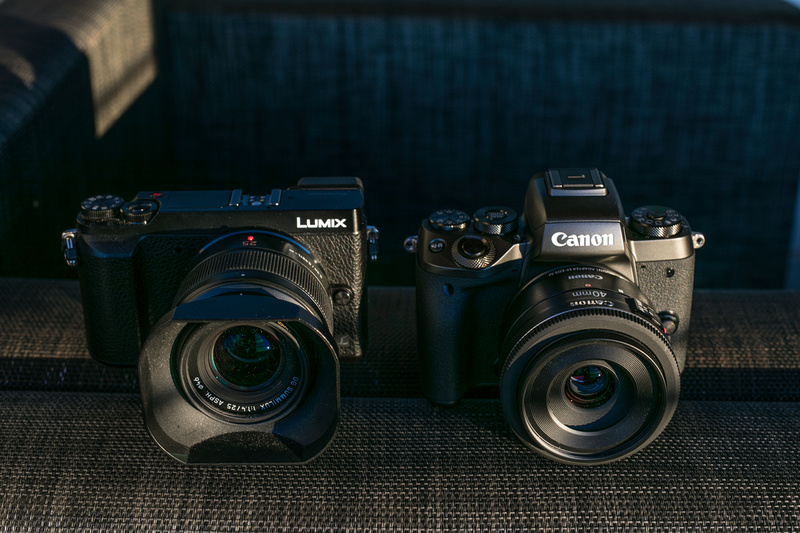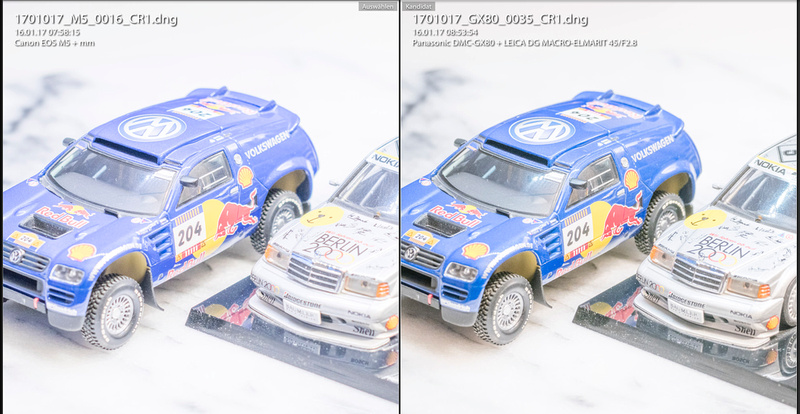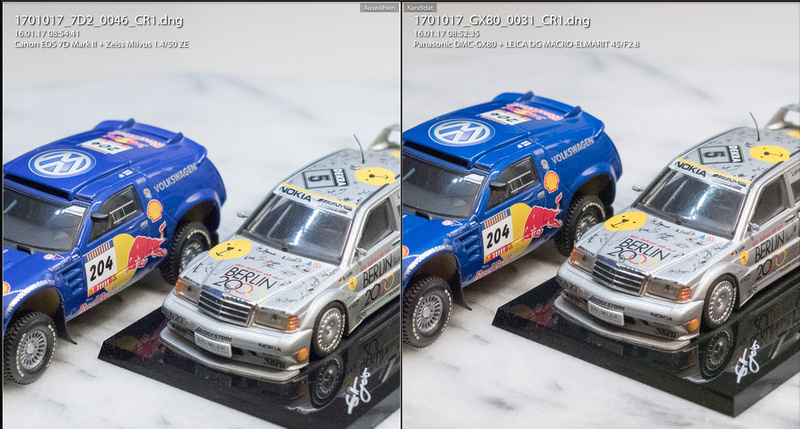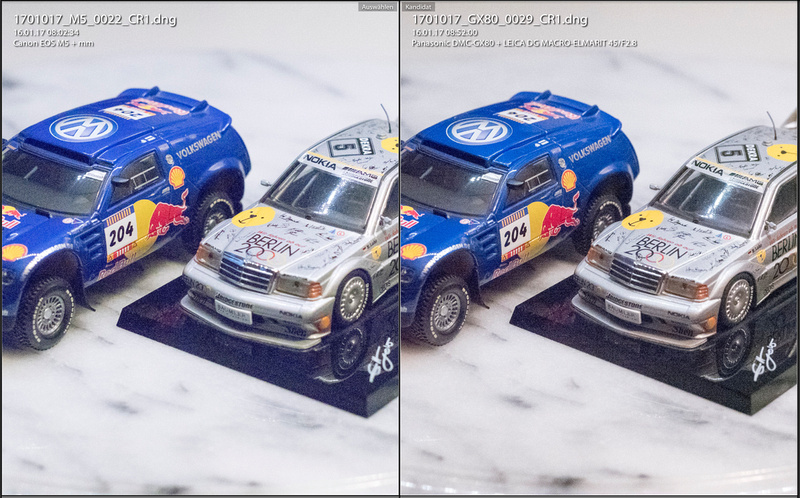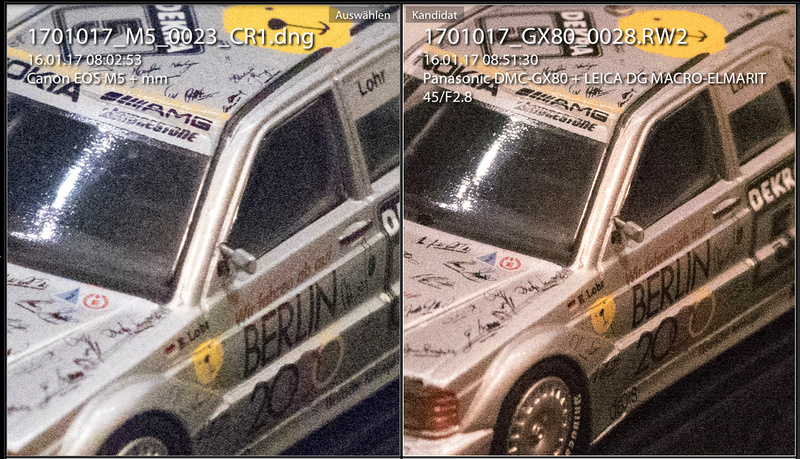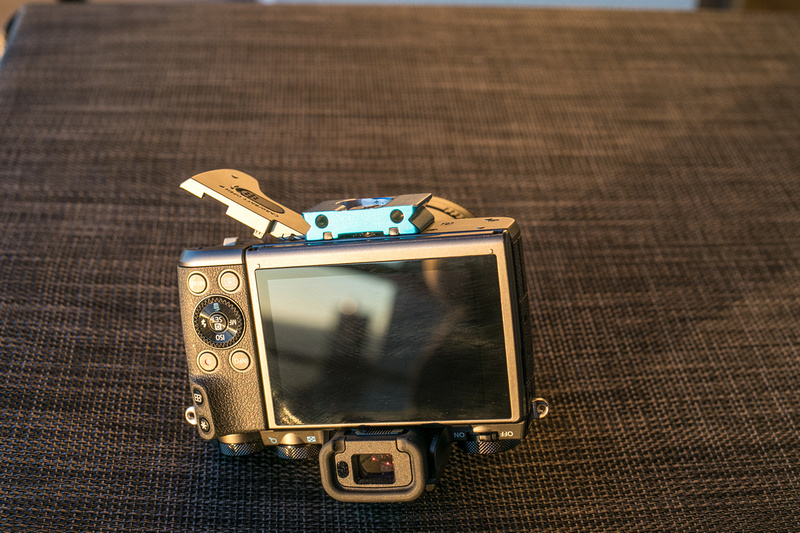Canon EOS M5: A great mirrorless camera from Canon?! A comparison with µ43 and APS-C DSLR (EOS 7D2)MotivationUsing mirrorless is a hype today. I am shooting mirrorless since 2009 - 7 years. I started with the Panasonic Lumix GH1. I bought it because I was scared to take my EOS 5D MkII to India. (Which was nonsense-by the way: carrying camera gear to India is pretty save - but that I learned in the following years) The tiny little ones had accompanied me everywhere -whenever I did not want to carry the big guys. USA, Turkey, Italy, China, Japan etc - for whatever reason, mainly to have not too much luggage with me. Or for outdoor sports like Skiing, Mountainbiking and such kind of events. And I had them with me in addition to the big guys...
Meanwhile I do have quite a bit of µ43 gear. µ43 has small camera bodies and small but excellent glass, too. And I developed my concept of shooting with prime lenses. This is based on the experience of comparing full format with µ43 and an iPhone the conclusion was: shooting with prime lenses with the highest amount of bokeh and top image quality over the whole image circle wide open delivers a differentiator to the so called iphoneography.... http://bit.ly/2iJMHS5 And since glass is heavy, it is better to carry less glass and more bodies. The concept behind: http://bit.ly/1CtrDbl Canon was out of the mirrorless business. Sony went into it, pretty successful with the Alpha Series, the APS-C Series 6x00 or the 7 in full format. I was looking into it. Yes I was considering to buy one. Mainly because of the 5 ax IBIS. But Sony was sacrifying the advantage of mirrorless bodies with the G-Master lenses: An Alpha 7 with the G-Master f2.8 24-70mm & the 70-200mm weights more or less exactly the same like a Canon EOS 5D Mark 4 with the similar lenses from Canon.... Where is the Killer for shooting mirrorless??? I do not see it...
But the EOS M5 showed up. I had it in my hands at Photokina 2016: The ergonomics are among the best in class: the reference is the Panasonic Lumix G7/G80. And the EOS M5 is pretty close. And in some regards even better.... MethodologyMaybe the scientific expression is a bit over the top for this more hands on real world review. The idea behind this this review is to find out where are the strength and the deficits of the new EOS M5:
Actually I bought the camera with the EF adapter. Therefore I can use all my Canon glass. The native EF-M-lenses are on the way. They should arrive in the next days.... I will add reviews about this gear as soon as it arrives - and I find some time to write about it... Many of the photos with the Camera I have taken with all 3. Since I did not have native glass for the EOS M I took the EF 40mm f2.8 STM pancake lens. The FullFormat equivalent focal range is 64mm. For the Lumix I have chosen the lens closest to 64mm: The Sigma 30mm f2.8 Art lens. Both lenses are known to perform excellent. Therefore the comparison seems to be fair. Build Quality and SizeThis camera feels solid: it has more weight than the Lumix G7 but all surfaces feel plasticy. The body has no weather sealing - unfortunately. Opening the battery case feels a bit cheap, too: I hope it will keep in a good shape for a long time... What did not felt really great is the lens mount side of the adapter: this feels a bit tight - and not buttery like the normal Canon lens mount feels. But again: the mount even with the adapter is rock solid. I made some trials with the EF 100-400mm lens. It works, too... In terms of size: this was very astonishing when I had the camera the first time in my hand: it is pretty tiny - but it is not too small. and it looks ab bit DSLR-ish. Sizewise: well: it is definitely not larger than my GX80...
The images above are showing quite a nice comparison of the size of the EOSM5 in comparison to the Ergonomics & HandlingAs mentioned in my Photokina-blog: this camera has state of the art ergonomics: the dials and buttons are pretty useful. The look and feel is really Canon like. No much surprises from the pint of view. But there are some downsides. Coming from the single digit EOS-Cameras the amount of menus is reduced and therefore there are less options available. But from the handling point of view: the 4 dials on the top are working great:
From the rear since there are a couple more buttons there.
The info button is important to change the viewfinder. The viewfinders are not synchronized: If you see the grid in the EVF this does not mean that you will see it on the screen and vice versa. To change this you have to push the Info Button. Interesting is the control dial in the back. The Q button in the center works as well. but the other ones are context sensitive. The other functionalities are mostly switched of, but the ISO button works always - and the wheel is used for changes... Another interesting button is the AF Frame selector button: Using the EVF and manual focus lenses this button opens the front dial to zoom into the picture for sharpening. This area can be moved with the touch screen. If this is switched off that the control dial can be used to move this window. But again: pretty much known from other EOS cameras...
The tilt screen helps a lot shooting in landscape orientation...
In Selfie mode.... This is a nice feature, too. but it does not work with a tripod... Focusing with the M5 is really new and nice experience. Canon has done a very good job. Especially for those who like to manual focus. Which is sometimes needed - especially in macro photography or in product shootings. The way the camera integrates the touch AF is just great. to touch the sensor and moving the field where you are looking closer -up to 10x, as usual in Canon live view- is very easy. You can separate the area, where to use to certain areas on the touch screen. For me I have to adapt a bit to this camera: normally I look with the left eye through the viewfinder. With EOS M5 it makes much more sense to use the right eye - and move the area of interest on the touch screen.... The speed of the autofocus left some mixed feelings. I tetsted it against the Lumix GX 80. The M5 was half as fast. My comparison was based on a setup where I focused close by ca 50cm and infinity. It took 17 sec with the Lumix to take 20 exposures. With the M5 I had 10 shooters in the same time.... But: the lens on the Lumix was a Leica 25mm f1.4 - native for this camera. The Sigma I used for the rest of the shots was definitely much slower.... I will repeat the test as soon as I have native glass available.... The ComparisonBasically I compared my range of non full-frame cameras: The The 7D MkII as reference for APS-C, the EOS-M and the GX 80.
Left: 7DMkII with the Milvus 50mm f1.4, EOS M with the Nifty-Fifty and the Lumix with the 45mm f2.8
This is the EOS M with the EF-M 22mm f/2 STM and the GX80 with the Leica 15mm f1.7... In terms of "bokehliciousness" spoken: f/3.2 vs f3.4... I would say: flat out....
Very easy to see: the EOS M has a much larger screen than the Lumix.... Image QualityThis is the main topic. There is no doubt for me: size matters. Larger pixel are counting more photons offering better low light performance. And more pixel are offering less visible noise. There are still people out having doubts but for me this is quite clear... For this comparison I dod not made any "normal" images. I clearly wanted to see extrema. So in most of the cases the images are "stressed". During my last trip to the USA I was a bit disappointed from my 7D2. When pushing the shadows of my 5D4 I got so much more detail that the 7D2 got a bit boring.... Now I wanted to see: what does the EOS M5 delivers....
First a comparison between the EOS 7D MkII and the GX80. 16MP vs 20MP. And a different aspect ratio. Tricky to compare. But I hope you agree: APS-C and µ43 are pretty close....
The comparison between the M5 and the 7D shows a different picture: the M5 delivers more between the darks and the highlights....
This becomes more clear looking at the 1.1 images... beside less noise at the M5. But this might be caused by the larger pixel count....
If we compare the M5 with the GX80 it gets even clearer: less overexposed highlights amor more details in the dark parts.... Even more visible at the night shots:
And at least the comparison between all 3: The image is pushed +5 EV, the highlights are trimmed by -100% but the shadows pushed +100%..... But the message get´s clear: The new canon sensors are delivering really nice results.... ISO PerformanceNow comes a bit of boring stuff... Pixel peeping. The photos shall not show "nice" but should inform... therefore I stressed the images a bit. And found this pretty interesting. The processing was a bit weird...: I had to crop the EOS images from 3:2 to 4:3, therefore the pixel count of the 7D MkII was reduced from 20 MP to < 18 MP... pretty close to the 16MP Pixel count of the GX80; the M5 was reduced to ca 21 MP... Additionally I changed the white balance to Tungsten to balance the colors. Than I stored the RAW files as .DNG without any further processing. The first 2 images show the amount of details in the shadows. Therefore the I pushed the shadows to the max and the EV + 2....
For me the results are pretty interesting. You can clearly see the amount of detail you see in the M5 in comparison to the 7D. But what has astonished me: the GX80 shows even richer colors.....
7D vs GX80 @ ISO 3200
M5 vs GX80 @ ISO 3200 At this ISO levels for me the GX80 and the 7D MkII are more or less flat out. The M5 has a bit of an advantage...
The 2 images above are showing ISO 6.400; the result is similar, Id give the M5 an edge above the other two. But the tiny GX80 shows quite a decent performance for its pixel pitch.
ISO 12800....
The ISO 12.800 shows a bit of the problematic in this comparison: the scale is different. On the pixel level: the Leica lens shows no color findings, while the Zeiss shows a bit... and the nose level is quite similar...
At the full size image the M5 on the left looks a bit clearer for me. but again: the GX80 is pretty good....
These are the files @ 12800 with less processing....
The last 2 images show the performance @ Max ISO. The 7D MkII is limited to ISO 1600 while the other 2 are offering ISO 12800. It shows the limits of all cameras. But here I would say that -astonishingly the GX80 is doing better than expected... VideoI am not a video guy at all. The camera just shoots Full HD, no 4k. There are no video profiles like c-log. Is it useless therefore? Definitely not. I did a couple of videos, my daughter likes to shoot with it, too. A view remarks to video shooting:
Here is one excample which I shot handheld with the Milvus 50mm f 1.4 and manual aperture... I would say not that bad. For me killer was the electronic IBIS.
This little film is straight out of camera. I used the internal microphone. You can here quite a bit of background noise. The film is totally unedited.
Lens selection.What is a bit annoying to me is the lack of native prime lenses - as well as the lack of fast standard zooms. Today I carry the following lenses with me:
With this selection I cover most of the practical cases needed. On my first trip to San Francisco I had my Milvus 50mm f1.4 with me. A great combination. But I was missing the longer end... and the 100mm has quite the same size like the Milvus.... CuriositaOne topic is quite amazing: You can use the camera with autofocus in combination with end Extander 2x and f.i. the EF100-400mm f/4-5.6 L USM. No other Canon Camera does this... Pretty amazing. The lens has f11 on the long end as max aperture and autofocus works just fine!!! 1280mm effective focal length.... For wildlife a really interesting option.... But Some topics are pretty strange on this camera:
But coming from the Lumix GM Cameras: there is a work around....
Update: It was pretty easy to make it working.... And now both works: the openings as well as movement of the tilting screen... ConnectivityOne great topic of the EOS M5 is the connectivity. It connects easily with the Camera Connect app. And what makes it so great is the ease of use. In comparison to Panasonics image app one big advantage is that you can shoot RAW - and download jpg´s to your iPhone or iPad. it just works.... And in addition: you can shoot thethered wireless. These feature also works. No need for a cable connect.... I have so much fun shooting with really good glass and than just post it on instragram... Look at #eosm5 under my integral account "delight photos": https://www.instagram.com/delightphotos/ VerdictFirst of all: congratulation to Canon for a very useful camera.
It is a good camera with great image quality. I hope to get my new EOS-M native lenses soon. I will report on their image quality in a separate blog post. In terms of value for money: that´s a different story: due to my taste: there is no big improvement against an Lumix G80/81/85... But in terms of specs: a lot is missing:
For me a fair price point: 800 -850€. I hope Canon will be able to add more EOS M Cameras, especially for beginners. As soon as this shows up: i will consider to change my camera recommendation for beginners which is Panasonic Lumix so fare. Update on my EOS-M native lensesI ordered 3 native prime lenses for the system:
It is a pleasure to have all these lenses. The Samyang 12mm f 2.0 is just great. it works perfect, great built quality and a really superb image quality. The only downside is that Samyang does not have a chip built in for transferring EXIF-Data and focus confirmation. The 22mm f2.0: I love this lens. It is a great performer. I do not miss anything with this lens. It is just great. I think I will write a review on it soon. 2 thumbs up! The 28mm f3.5 is giving me mixed feelings: optical a great performer, but pretty slow. The idea of build in light works just great. You can make images you can make with no other lens. But built quality: the mount is made of plastic. for 380€. Ridicolous. A new 35mm f2.8 is announced: I hope Canon has made a better choice of materials.... What´s next?I will keep my eyes open for new native lenses. I do hope that other 3rd party manufacturers release their APS-C lenses for EOS-M-Mount. Like Sigma or Zeiss... I guess the one or the other lens would find its way into my camera bag... MiscelleanousAll products shot were made with the EOS 5D MkIV. The shots with the evening light wer made with the Milvus 50mm f1.4. The shots indoor on wood were made with the EF 100mm f/2.8 L IS USM. You can find the product shots under https://goo.gl/5AQcPh And the screenshots under: https://goo.gl/mxTHcZ Comments
No comments posted.
Loading...
|




